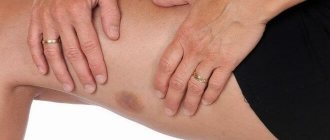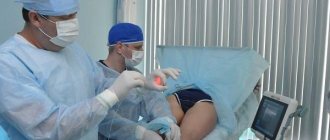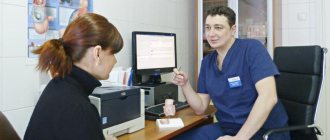What is the essence of coagulation of hemorrhoids?
Infrared coagulation of hemorrhoids involves the local thermal effect of waves on problem areas generated by an infrared ray. Using this method, the blood supply to the hemorrhoidal tumor is disrupted, which ultimately leads to its destruction and falling off.
Infrared coagulation is recommended for the treatment of stages 1 and 2 hemorrhoids
Radio wave coagulation of hemorrhoids involves the use of high-frequency waves, non-contact incision, and vaporization of blood vessels. Thanks to heating, a cutting effect is produced, which subsequently leads to the destruction of the node.
At stages 3-4 of hemorrhoids, radio wave coagulation is usually recommended
Both methods are quite effective. The specialist chooses the technique that he considers most optimal for a particular individual case.
Minimally invasive procedures are painless and have minimal risk of postoperative complications. The patient returns to his usual rhythm of life almost immediately after the procedure.
Statistics show that patients usually tolerate both manipulations well. For both procedures, specialized medical equipment is used.
To carry out infrared coagulation of hemorrhoids:
- electrical system,
- applicator holder
- applicator equipped with a hard LED based on quartz glass.
To carry out radio wave coagulation:
- apparatus emitting high-frequency waves
- ultrasonic device to control manipulation.
TOOLS
Infrared coagulator (photocoagulator)
Manufacturer: Lumatec (Germany)
Description: Infrared coagulator (IRC) is a device with a wide range of applications. In coloproctology it is used for photocoagulation of internal hemorrhoids, removal of perianal genital warts, treatment of anal fissures, stopping bleeding, etc. When working in the anal canal, the device is used with an anoscope. The infrared coagulator can be equipped with light guides of various lengths and diameters, with corresponding tips.
Application area:
- proctology - ideal for the treatment of internal hemorrhoids stage I, II, treatment of anal fissures, removal of papillomas, genital warts of the anal canal and perianal area, stopping bleeding after removal of nipple hypertrophy or rectal polyps, stopping bleeding formed after a biopsy of the mucous membrane, etc. .
- gynecology is a simple method of treating the cervix in the case of: exudative ectopia, zone of vascularization exchange, chronic inflammation of the cervix, erosion, genital warts, grade 1-2 dysplasia, etc.
- dentistry - stopping bleeding after tooth extraction, etc.
- otolaryngology - stopping bleeding after removal of tonsils, endoscopic treatment of bleeding of the nose and larynx.
- surgery - stopping bleeding: in the kidneys, liver, spleen, bleeding in malignant tumors that cannot be removed, etc.
- dermatology - treatment of angiomas, removal of warts, boils, tattoos, etc.
- cosmetology
Operating principle:
The infrared coagulator consists of an electrical system and a manual applicator gun. The applicator holder is installed on the top of the device body. The electrical system includes a current source and an electronic timer for the infrared beam. The infrared radiation source operates with a safe low voltage of 15V.
The applicator contains an infrared emitter with a reflector coated with 24-karat gold and a rigid quartz light guide. The surface of the beam exiting the light guide does not stick to the fabric; the surface and the light guide itself can be replaced.
During use, the shielding shell of the infrared radiation source transmits part of the scattered radiation along the light guide, through the tip. This radiation is absolutely harmless and corresponds in its spectral composition and intensity to a normal incandescent lamp.
The equipment is not intended for continuous use (which could cause overheating). It is designed to operate in pulse mode with a relatively short pulse duration.
ATTENTION! THE LIGHT GUIDE IS MADE FROM HIGHLY PURITY QUARTZ GLASS AND IS FRITTLE. A BROKEN OR CACKED LIGHT FIRE WILL NOT TRANSMIT RADIATION AND MUST BE REPLACED. SO YOU SHOULD TRY TO AVOID HIT.
Contents: the kit consists of a power unit, a manual applicator, a power cable, a light guide with a Teflon tip
Prices:
Name
| Catalog number | price, rub. | |
| Infrared coagulator included: power unit, power cable, manual applicator, light guide (diameter 6 mm, length 220 mm) with Teflon tip | CTL-3803/010 (HS-1) | 340000,00 |
| Accessories, consumables | ||
| Manual applicator (with reflector without light guide) with 1.5 m power cable | CTL-3803/501 | 96300,00 |
| Reflector lamp | CTL-1.09 | 17470,00 |
| Quartz light guide, diameter 6 mm, working length 220 mm. Curved | CTL-010 | 78640,00 |
| Teflon tips, diameter 6 mm, 10 pcs. packaged | CTL-613/10 | 21880,00 |
| Sapphire tip, diameter 6 mm | CTL-613/S | 27970,00 |
Availability: Check
| Contact person for purchasing equipment Tselikovsky Alexander Anatolievich 8-(903)-176-70-75 (cellular) |
Indications for coagulation for hemorrhoids
Infrared coagulation of hemorrhoidal tumors is recommended for patients with internal or combined forms of hemorrhoids.
The main indications in this case include:
- hemorrhoids at stage 1 or 2 of development,
- presence of hemorrhoids with bleeding,
- combined form of hemorrhoids,
- inability to achieve the desired therapeutic effect through ligation of hemorrhoids.
Indications for radio wave coagulation:
- hemorrhoids at stages 3 or 4 of development,
- the presence of internal hemorrhoidal neoplasms,
- the presence of external hemorrhoids.
Both types of coagulation are modern methods of treating hemorrhoids of various forms. The choice of method should be entrusted to a qualified specialist. He will take into account the peculiarities of the course of the disease, the shape and location of hemorrhoids, the type of complications, and evaluate the general symptoms. This will allow him to decide on the best method for his patient.
Principle of the method
An infrared coagulator is a device that allows tissue cauterization by contact method. It consists of a block and an applicator, which directly performs all manipulations on the rectum. The block is equipped with a timer that allows you to set coagulation parameters.
Using the applicator, the surgeon cauterizes the vascular pedicle of the modified cavernous bodies, causing their necrosis. Hemorrhoids treated in this way become empty and die, separating from the mucosa after a few days.
Advantages:
- minimal trauma to underlying tissues
- ability to set the time of exposure to infrared radiation with an accuracy of fractions of a second
- the ability to use minimal thermal energy for infrared irradiation
Flaws:
- limiting the number of nodes that can be coagulated in one manipulation (usually one intervention allows you to get rid of 1-3 nodes)
- high price
- limited indications for use.
Possible complications:
- bleeding – postoperative or during removal of a dead hemorrhoid
- hemorrhoidal thrombosis
- severe pain in the anus
- necrosis of mucous membranes
- addition of a secondary infection
Contraindications to coagulation of hemorrhoids
Infrared coagulation is not performed if the patient has an advanced form of the disease. In case of a purulent-inflammatory process, the procedure is most often not performed. With stage 3-4 hemorrhoids, radio wave coagulation is usually needed. Other contraindications include:
- damage to the rectal canal mucosa,
- presence of rectal fistulas,
- purulent inflammation,
- inflammation of a pronounced nature in the tissues of the pelvis,
- thrombosis.
Radio wave coagulation is not performed with the following contraindications:
- diabetes,
- old age of the patient,
- exacerbation of infectious diseases,
- epilepsy.
Make an appointment
Treatment of hemorrhoids
Appointment with a proctologist
Online booking of an appointment with a proctologist.
Phones:
+7 (812) 30-888-03
+7
Clinic address: St. Petersburg, Vyborg district, st. Asafieva, 9, k2, lit. A (metro station Ozerki, metro station Prospekt Prosveshcheniya)
Below we will discuss the main methods of treating hemorrhoids without surgery:
- Alloying hemorrhoids with latex rings
- Infrared coagulation of hemorrhoids
- Cryotherapy
- Sclerotherapy
Key principles of preparation for surgery
The patient receives full information about the preparation during a consultation with a proctologist. Before coagulation, the patient must undergo all necessary types of examinations:
- ECG,
- fluorography of the chest organs,
- general blood analysis,
- general urine analysis,
- anoscopy,
- palpation examination of the anus,
- Wasserman reaction,
- blood sugar test.
Additionally, colonoscopy or sigmoidoscopy may be prescribed.
The patient should also adhere to the recommendations: exclude fried, spicy and fatty foods from the diet 1 day before coagulation, as well as foods that promote gas formation. Before the procedure, you need to take a laxative. In some cases, an enema is used to cleanse the intestines.
What to expect from treatment with an infrared coagulator?
Bleeding from the anus occurs 7-10 days after the procedure, when the hemorrhoids disappear. Bleeding is usually minor and stops on its own.
- The patient is advised to use mild pain relievers and sit in a shallow bath of warm water (sitz bath) for 15 minutes at a time to reduce discomfort.
- To reduce the risk of bleeding, you should avoid taking aspirin and other nonsteroidal anti-inflammatory drugs (NSAIDs) for 4 to 5 days both before and after infrared coagulator treatment.
- It is recommended to take stool softeners containing fiber to ensure smooth bowel movements. If the patient strains during bowel movements, the likelihood of relapse increases.
How is coagulation of hemorrhoids performed?
Infrared and radio wave coagulation is performed under local anesthesia to eliminate possible discomfort during the procedure.
Infrared coagulation of hemorrhoidal cones requires a special knee-elbow position for the patient. Sometimes the procedure is performed in a different position, when the patient sits in a proctology chair, spreads his legs and tucks them in.
The doctor uses a dilator for the tissues of the perianal area
A special device, called an “anoscope,” is inserted into the rectal canal. The next stage of the procedure is to bring a quartz LED to the stem of the hemorrhoid.
Coagulation lasts about 2 seconds. If the neoplasm is large, in addition to the stem, its upper part is also treated
If the patient has several nodes, they are removed simultaneously or on different days. Repeated coagulation is recommended in this case 14 days after 1 session.
Radio wave coagulation also involves a special positioning of the patient in a proctology chair or on a couch. The device used allows for non-contact cutting, coagulation and vaporization of blood vessels using a high-frequency wave.
Evaporation (or heating) of soft tissues leads to their dissection
It is important to note that the electrode does not contact tissue and cannot heat up. The surrounding layers are not destroyed during the procedure.
Possible complications after surgery
After coagulation of hemorrhoids, some patients experience pain for the first time. Their appearance may be due to the location of the hemorrhoidal tumor below the dentate line, where pain receptors are located. The proctologist will advise the patient to use rectal suppositories and drugs with an analgesic effect.
It is better not to self-medicate, so if pain occurs after coagulation, you should immediately contact a specialist and solve the problem together.
Pathological complications after coagulation also include anorectal thrombosis, rectal bleeding, and necrosis of hemorrhoids.
Rectal bleeding is possible several days after the procedure. This is usually associated with the hemorrhoid falling off. As for node necrosis and anorectal thrombosis, they usually manifest themselves with extensive coagulation.
To eliminate the risk of possible complications, it is recommended to strictly adhere to all doctor’s recommendations after coagulation.
Efficiency
Infrared coagulation of hemorrhoidal disease is highly effective, as it significantly reduces tumors, helps stop bleeding and improves overall well-being.
The patient who has undergone this procedure can return to normal activities within a day. Rehabilitation lasts on average about one week.
However, it should be noted that some patients may experience recurrence of the disease within five years after coagulation. Constant monitoring by a proctologist is required. For this, the patient needs to undergo regular examinations.
It is also important to note that infrared coagulation of hemorrhoids is not performed at stages 3 and 4 of the disease, since in this case it is ineffective.
Radio wave coagulation is often better tolerated and the risk of relapse is lower, but this technique is usually used for complicated and late stages of hemorrhoids.
After infrared photocoagulation
In most cases, the initial stages of hemorrhoids require a one-stage operation. Repeated infrared photocoagulation is carried out if the patient has 4 or more nodular formations. At the end of the procedure, the patient may experience minor pain and discomfort that lasts up to 6 hours. To relieve pain, it is enough to take non-narcotic analgesics (ibuprofen and paracetamol).
The first few days after infrared photocoagulation, the patient is recommended to adhere to a gentle diet. During this period, it is prohibited to drink carbonated and alcoholic drinks. The daily diet should be divided into 6-7 meals. This significantly reduces the mechanical pressure of food masses on the walls of the large intestine. It is advisable to avoid heavy physical activity and sports for two weeks.
After infrared photocoagulation of hemorrhoids, full restoration of functionality occurs within 2-3 days. During this period, the patient must strictly observe the rules of personal hygiene, especially after bowel movements.
Disadvantages of coagulation
The disadvantages of infrared and radio wave coagulation include the risk of possible complications and relapses. After the procedure, patients may have complaints:
- painful syndrome,
- problems with bowel movements,
- risk of thrombosis and rectal bleeding.
In addition, it should be noted that coagulation techniques can eliminate the consequences of the disease, but they do not directly affect the very cause of its development.
Cost of treatment
The price of infrared and radio wave coagulation of hemorrhoids depends on their number, shape, complexity of the case and volume of intervention. The approximate cost of one procedure is from three to ten thousand rubles.
When choosing between infrared and radio wave coagulation of hemorrhoids, it is better not to waste time and entrust the solution to this issue to a specialist.
Depending on the stage of the disease ( I , II , III , IV ), some features of its manifestation, the age and health status of the patient, the doctor will determine what will be the most effective and safe .
Clinic for the treatment of hemorrhoids in Moscow
The multidisciplinary clinic "MedicCity" employs highly professional coloproctologists who can offer you various methods of treating hemorrhoids.
After reading reviews about the treatment of hemorrhoids and reviews about surgery to remove hemorrhoids, you can form your own opinion about the procedure. Our clinic performs various operations to treat hemorrhoids, including desarterization. Prices for proctological manipulations are average for the capital.
You can see prices for surgery to remove hemorrhoids here.








